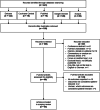Patient-relevant outcomes: what are we talking about? A scoping review to improve conceptual clarity
- PMID: 32600321
- PMCID: PMC7325243
- DOI: 10.1186/s12913-020-05442-9
Patient-relevant outcomes: what are we talking about? A scoping review to improve conceptual clarity
Abstract
Background: With respect to patient-centered care, measuring care effects based on patient-relevant outcomes is becoming increasingly important. There is some uncertainty about what outcomes are particularly relevant to patients and who determines their relevance. To determine this, we conducted a scoping review of the international literature with the aim to improve the conceptual clarity regarding (1) the terminology used for supposedly patient-relevant outcomes, (2) the variety of outcomes considered patient-relevant, and (3) justifications for the choice of these specific outcomes.
Methods: We conducted a systematic search in Embase, PubMed (including Medline), Cochrane Central, Scopus, and Google Scholar with a special focus on article titles. Search terms included patient-relevant, patient-important, patient-preferred, and outcome(s), endpoint(s), parameter(s), indicator(s). We limited the search period from January 2000 to July 2019. Full-text articles reporting outcomes that were described as patient-relevant met the inclusion criteria. Two researchers independently analyzed all eligible articles applying quantitative and structuring content analysis.
Results: We identified 155 articles, 44 of which met the inclusion criteria. A content analysis revealed 35 different terms used with regard to patient-relevant outcomes. However, authors predominantly referred to patient-important outcomes (23 articles, 52.3%) and patient-relevant outcomes (17 articles, 38.6%). A structuring content analysis of all extracted outcomes revealed a total of 281 codes, pooled in 32 inductive categories. Among these, the following categories dominated: symptoms, adverse events/complications, survival/mortality, pain. In just 16 of the articles (36.4%), authors provided justifications for the choice of the outcome being based either on patient and/or expert opinions. In another 13 articles (29.5%), no justification was provided.
Conclusion: This scoping review on patient-relevant outcomes was driven by the questions (1) what outcomes are particularly relevant to patients, and (2) who determines their relevance. We found a wide range of supposedly patient-relevant outcomes, with only one third of articles involving patients in the justification of the outcome selection. In view of this conceptual uncertainty it appears difficult to determine or even to compare a particular patient benefit of interventions. A set of generic outcomes relevant to patients would be helpful to contribute to a consistent understanding of patient relevance.
Keywords: Patient involvement; Patient preference; Patient relevance; Patient-centered care; Patient-relevant outcome.
Conflict of interest statement
The authors declare that they have no competing interests.
Figures


References
Publication types
MeSH terms
LinkOut - more resources
Full Text Sources
Miscellaneous

